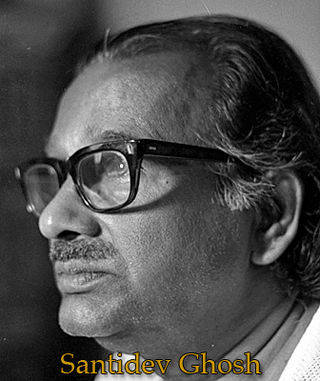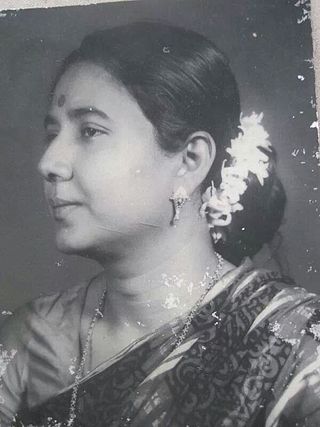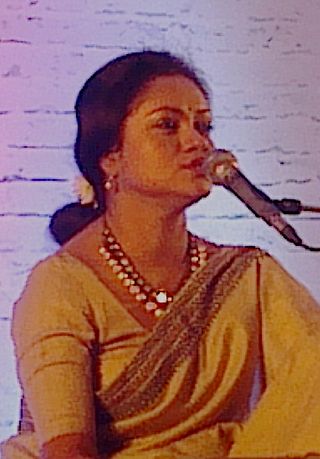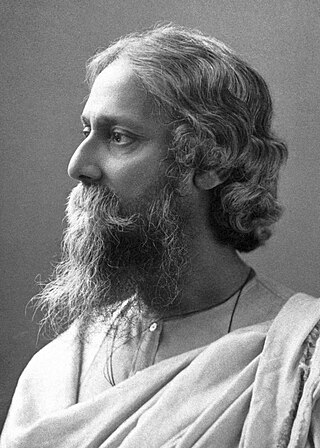
Shantiniketan is a neighbourhood of Bolpur town in the Bolpur subdivision of Birbhum district in West Bengal, India, approximately 152 km north of Kolkata. It was established by Maharshi Devendranath Tagore, and later expanded by his son, Rabindranath Tagore whose vision became what is now a university town with the creation of Visva-Bharati. It is also the birthplace of Amartya Sen, an Economist, Philosopher, & Nobel Laureate

Visva-Bharati, is a public central university and an Institute of National Importance located in Shantiniketan, West Bengal, India. It was founded by Rabindranath Tagore who called it Visva-Bharati, which means the communion of the world with India. Until independence it was a college. Soon after independence, the institution was given the status of a central university in 1951 by an act of the Parliament.

Kanika Banerjee was a Bengali Rabindra Sangeet singer.

Patha Bhavana is an institution of primary and secondary education in Santiniketan, West Bengal, India. Founded by Nobel laureate Rabindranath Tagore in 1901, starting with only five students, the school is characterized by its philosophy of learning with the heart in closeness to nature without any superficial barriers between teachers and students, as opposed to the strict, repetitive and the rote learning system that was mainstream during Tagore's childhood. Often referred to as an ashram system, initially what started out as this school, later grew into what is now Visva-Bharati University. It is one of the two primary and secondary school affiliated with the Visva-Bharati University; the other being Siksha Satra.

Suchitra Mitra was an Indian singer, composer, artist exponent of Rabindra Sangeet or the songs of Bengal's poet laureate Rabindranath Tagore, professor, and the first woman Sheriff of Kolkata. As an academic, she remained a professor and the Head of Rabindra Sangeet Department at the Rabindra Bharati University until 1984. Mitra was a playback singer in Bengali films and was associated for many years with the Indian People's Theatre Association.
Guru Kelu Nair was a renowned Kathakali dance artist and teacher.

Santidev Ghose was an Indian author, singer, actor, dancer and maestro of Rabindra Sangeet.

Nilima Sen was a famous Rabindrasangeet singer.

Dinendranath Tagore, also known as Dinu Thakur, was a Bengali musician, singer and poet.
Rajeshwari Dutta born as Rajeshwari Vasudev was an Indian singer, considered one of the best-known exponents of the songs of Rabindranath Tagore.

Rezwana Choudhury Bannya is a singer from Bangladesh. She is an exponent of Rabindra Sangeet, the songs written and composed by Rabindranath Tagore. She has won many awards including Bangladesh's highest civilian award, the Independence Day Award (2016) and India's fourth highest civilian award, Padma Shri (2024).

Kala Bhavana is the fine arts faculty of Visva-Bharati University, in Shantiniketan, India. It is an institution of education and research in visual arts, founded in 1919, it was established by Nobel laureate Rabindranath Tagore.

Adity Mohsin is a Bangladeshi Rabindra Sangeet singer.

Rabindra Jayanti is an annually celebrated cultural festival, prevalent among Tagorephiles around the world, in remembrance of Rabindranath Tagore's birthday anniversary. It is celebrated in early May, on the 25th day of the Bengali month of Boishakh, since Tagore was born on this day of the year 1268 of the Bengali calendar. Every year, numerous cultural programmes and events, such as: Kabipranam (কবিপ্রণাম) – the songs, poetries, dances and dramas, written and composed by Tagore, are organised in this particular day, by various schools, colleges and universities in Bengal, and is also celebrated by different groups abroad, as a tribute to Tagore and his works. Throughout the globe, Tagore's birth anniversary is largely celebrated at Santiniketan, Birbhum in West Bengal, chiefly in Visva-Bharati University, the institution founded by Tagore himself for the cultural, social and educational upliftment of the students as well as the society. In 2011, the Government of India issued a five-rupee coin to mark the 150th anniversary of Rabindranath Tagore's birth.

Pratima Devi (1893–1969) was an Indian Bengali artist, widely known for her artistic abilities. She was the wife of Rathindranath Tagore. The poet took special interest in developing her capabilities.

Indira Devi Chaudhurani was an Indian literary figure, author and musician. Born to the Tagore family, Indira was the younger child of Satyendranath Tagore and Jnanadanandini Devi and younger sister of Surendranath Tagore. She is noted for her work in scoring the music for a number of songs by her uncle Rabindranath, with whom she was particularly close. Indira Devi Chaudhurani died in 1960.
The following is a list of notable people associated withVisva- Bharati University and/or Santiniketan, a neighbourhood in Bolpur city in West Bengal, India:
Sailajaranjan Majumdar was a distinguished exponent and teacher of Rabindra Sangeet.

Jamuna Sen was an Indian artist, known for her design work in a variety of mediums including Batik and Alpona as well as developing, in an Indian context, a variety of traditional crafts from across the world. She was a pioneer in establishing the practice of Batik in India in modern times. Daughter of Nandalal Bose, a central figure in modern Indian art, she was brought up in the artistic and intellectual milieu of Santiniketan and made significant contributions in the field of design.
Pallavi Krishnan is a leading exponent of the dance form, Mohiniyattam. She received the Sangeet Natak Academi award for 2022 in Mohiniyattam from president Murmu.















